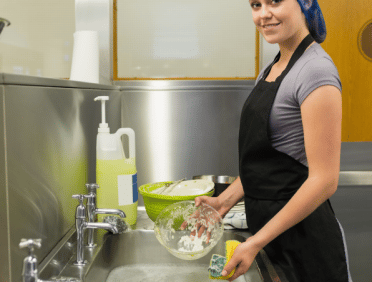The Level 2 Food Safety course is a cornerstone in this effort, offering thorough training to individuals in the United Kingdom. Let’s go deeper into the course’s numerous components to understand why it’s more than simply a requirement but also a critical investment in the well-being of both customers and the food sector itself.
Microbiological Hazards: Unseen Threats in Our Food
Understanding the world of culinary creativity, where each dish is a canvas for flavours and textures, reveals an invisible domain of possible threats; microbial risks. These minuscule intruders, while invisible to the naked eye, can have serious ramifications for the safety of our food.
The food safety course delves into the complexities of microbiological dangers, teaching participants how to detect, prevent, and manage these unseen threats that lurk in our products.
A Journey into Microbiology
The course begins with an exploration of microbiology. Participants investigate the characteristics of numerous bacteria that may pose a risk to food safety. Understanding bacteria, viruses, and parasites lays the framework for successful preventive interventions.
Unveiling the Invisible Culprits
Microbiological risks can be subtle, making them difficult to detect without sufficient understanding. The training explains how these invisible hazards might jeopardise food safety and, as a result, public health.
Practical Measures for Prevention
Knowing is just half the battle. The seminar emphasises practical methods for preventing microbial contamination at all stages of food handling. Participants gain concrete knowledge on topics ranging from strict cleanliness measures to correct storage techniques.
Food Contamination: Guarding Against Culinary Intruders
There is a possible threat hovering in the complex dance of culinary creation, where components harmonise to make delectable marvels. It is unseen yet capable of causing harm. This threat is food contamination, an unwanted visitor that can jeopardise the safety and integrity of any dish.
The food safety course covers the complexities of protecting against these culinary intruders, ensuring that what hits the plate is not only delicious but also safe to consume.
The Anatomy of Contamination
Food contamination can occur from a variety of sources, and the course covers these details. Understanding the sources of contamination, particularly cross-contamination, is crucial for maintaining a safe and sanitary food processing area.
Preventing Contamination at Every Turn
Practical ways for preventing contamination become the focus, with participants guided through best practices for storage, preparation, cooking, and serving. By teaching these practices, the course prepares students to be culinary guardians.
Personal Hygiene: The Frontline Defence
Culinary craftsmanship is where creativity meets precision; one sometimes overlooked feature serves as the frontline defence, guaranteeing that every meal served is not only a pleasure to the palette but also a dedication to safety. Personal hygiene is the first line of defence, serving as the foundation for safe and responsible food handling.
Let’s look at why personal hygiene is more than just a collection of guidelines; it’s a culture that protects both culinary professionals and the customers they serve.
The Impact of Personal Habits
Participants learn that personal habits are more than just individual preferences; they can have a direct impact on the safety of the food they touch. The necessity of sanitation, adequate handwashing practices, and appropriate dress for food preparation workers is emphasised.
The Chain of Hygiene Responsibility
Personal hygiene is more than simply an individual obligation; it is a link in a larger chain. The training emphasises the interdependence of personal hygiene practices, ensuring that every link in the chain contributes to a continuous commitment to food safety.
Safe Food Handling Practices: From Arrival to Plate
Culinary art is where flavours come to life and textures dance on the palette; food’s journey from the kitchen to the plate is a symphony of safe food handling techniques. It’s more than a habit; it’s a dedication to making sure that every bite is not only delicious but also safe to eat.
Let us look at a holistic approach to safe food handling, from the delivery of components to the final presentation on the plate.
A Comprehensive Approach
Food’s journey from the minute it enters a kitchen to the time it reaches the plate is scrutinised. The training covers all aspects of safe food handling, including receiving, storing, preparing, cooking, and serving.
Mitigating the Risk of Foodborne Illnesses
The training programme seeks to reduce the risk of foodborne illnesses by implementing best practices at each stage. This is more than just following regulations; it is about instilling an attitude that values the integrity of the food supply.
Hazard Analysis and Critical Control Points (HACCP): Systematic Vigilance
A greater grasp of the delicate tapestry of food safety, where precision is important and consumer well-being is non-negotiable, reveals Hazard Analysis and Critical Control Points (HACCP) as a beacon of systematic vigilance. HACCP is more than just industry jargon; it is a comprehensive approach to identifying and controlling possible risks at all stages of food production.
Let us peel back the layers of this methodical vigilance to discover why HACCP is more than simply a collection of rules; it is a philosophy that protects the integrity of the culinary experience.
Beyond Acronyms
HACCP is more than simply a collection of acronyms; it represents a methodical technique for detecting and controlling food safety problems. The course introduces HACCP principles and their practical implementation in diverse food-related activities.
Aligning with International Standards
Participants learn how HACCP matches international standards, emphasising its status as an internationally accepted approach for assuring food safety. The workshop encourages participants to view HACCP not as a checklist but as an attitude.
Food Safety Legislation and Enforcement: The Legal Landscape
There is a silent guardian who ensures that every meal on a table is not just a culinary joy but also a guarantee of safety. This guardian is none other than the framework of food safety legislation, a set of rules and regulations intended to protect public health and instill confidence in the culinary experience.
Let’s look at the legal structure that controls the food business, as well as the critical role that enforcement plays in maintaining compliance.
The Legal Imperative
Understanding the legal landscape is an essential component of responsible food management. The course discusses essential food safety legislation and regulations applicable in the United Kingdom, emphasising their importance in protecting public health and ensuring compliance.
The Role of Regulatory Authorities
Participants get insight into the responsibilities of regulatory authorities, including how they enforce food safety standards. Individuals who understand the legal landscape are better able to contribute to a compliance culture.
Temperature Control: The Linchpin of Bacterial Proliferation
In food preparation, where flavours merge and textures are polished, a silent conductor orchestrates the safety of every culinary creation: temperature regulation. It is more than just an issue of doneness; it is the determining factor in whether hazardous bacteria proliferate or die.
Let’s look at why temperature management is more than just a culinary technique; it’s a defence against the unseen menace of bacterial growth.
Bacteria and Temperature
Bacteria flourish in specific temperature ranges, and this course investigates the relationship between temperature and bacterial multiplication. Understanding this key is critical to limiting the spread of dangerous germs.
From Storage to Cooking: Guidelines for Optimal Temperatures
Guidelines for maintaining proper temperatures during various phases of food handling are offered. Participants discover how temperature management is an effective weapon in the fight against foodborne infections, whether they are preserving perishables or cooking raw materials.
Cleaning and Disinfection: A Clean Kitchen is a Safe Kitchen
When it comes to the frenetic world of culinary production, where flavours mix and artistry takes front stage, the necessity of a clean kitchen cannot be stressed enough. Cleaning and disinfection are more than simply tasks; they are sacred rites that protect not only the aesthetics but also the safety of the culinary oasis.
Let us look at why keeping a clean kitchen is more than a routine in the world of gastronomy.
The Holistic Approach to Cleanliness
Maintaining a clean kitchen is more than just an aesthetic consideration; it is also a matter of safety. The course covers the best methods for cleaning and disinfecting surfaces, utensils, and equipment. Participants recognise that cleaning is more than a task; it is a comprehensive strategy to guarantee food safety.
Chemicals and Hygiene: Striking the Right Balance
The proper use of cleaning chemicals is emphasised by achieving the appropriate balance between effective disinfection and food preparation surface safety. The workshop helps participants make informed judgements about cleaning products.
Allergen Awareness: Safeguarding Against Unseen Threats
Looking at the rich landscape of the culinary world, where flavours and ingredients combine to create pleasurable experiences, there is a frequently hidden and sometimes hazardous element: food allergies. Allergen awareness is more than just a legislative obligation; it is an essential component of competent food handling, protecting against unknown hazards, and ensuring the safety of all diners.
Let’s look at why allergy awareness is more than just a checklist item; it’s a dedication to diversity, safety, and the art of culinary crafting.
The Rise of Food Allergies
As food allergies become increasingly common, allergen awareness is an important part of food safety. The course discusses common food allergens, their influence on individuals, and the need to protect against allergic reactions.
Labelling and Prevention
Understanding allergen labelling standards is critical. Participants learn how precise labelling helps to reduce cross-contact and protects allergy sufferers. This expertise is more than just compliance; it is about promoting inclusivity in the culinary experience.
Waste Management: Beyond the Bin
Appreciating the culinary world, where creativity meets precision and every ingredient matters, brings the often-overlooked issue of waste management to the forefront. It is more than just removing leftovers or packaging; it is a comprehensive strategy that incorporates environmental responsibility and sustainability.
Let’s look at why waste management is more than just a hassle; it’s a commitment to lowering the food industry’s environmental footprint.
The Overlooked Aspect
Effective waste management is a sometimes ignored part of food safety. The course addresses the correct disposal of both food and non-food waste. Participants learn how keeping a clean and organised environment promotes general hygiene and safety.
The Environmental Impact
Waste management is more than just cleanliness; it is also about reducing the environmental impact. The training encourages participants to consider waste reduction as part of a larger commitment to sustainability.
Record Keeping: The Paper Trail of Accountability
Record-keeping is not a static collection of records; rather, it is a living, breathing expression of a food company’s dedication to safety. The recordings created, ranging from temperature logs to cleaning plans, provide dynamic snapshots of daily operations. They record the ebb and flow of operations, providing a real-time snapshot of how safety rules are applied and followed.
Beyond Paperwork
Maintaining proper records is more than simply paperwork; it is a tool for accountability. The seminar emphasises the need to keep records on food safety practices. Temperature logs, cleaning schedules, and other paperwork help to ensure a systematic approach to safety.
A Tool for Continuous Improvement
Records are not static but rather a dynamic instrument for continual progress. The workshop teaches participants to see record-keeping as a proactive approach for spotting patterns, resolving difficulties, and improving food safety measures.
Food Safety Online Training
If you haven’t already got it, one way to start training yourself and your colleagues is to take a Food Hygiene course.
- Level 2 Food Safety Training: is an introductory course that covers basic food safety principles and practices. This qualification is designed for anyone who works with food, including front-line staff and supervisors. The course typically covers topics such as food hygiene, food contamination, food storage and preservation, and personal hygiene.
- Level 3 Food Safety Training: is an advanced course that provides a more detailed understanding of food safety principles and practices. This qualification is designed for managers and supervisors who have responsibility for food safety in their workplace. The course typically covers topics such as food safety legislation, HACCP principles, risk assessment, and management of food safety hazards.
Level 2 training is more basic and suitable for front-line staff, while Level 3 training is more advanced and suitable for managers and supervisors with greater responsibility for food safety in their workplace.
All of our courses have discounts for 10+ orders
Or SAVE OVER 50% and ensure your business is even safer by choosing one of our bundles:













